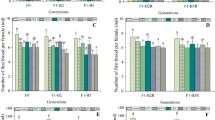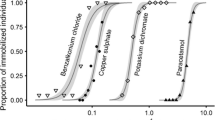Abstract
Although pharmaceuticals are increasingly found in surface waters, environmental levels of many of these compounds are not acutely toxic to model test organisms. Prior to conducting appropriate ecological risk assessments of pharmaceuticals, the mode of action-based biomarkers needs to be developed for non-target species. To evaluate toxicity of the β-adrenergic blockers propranolol and metoprolol on non-target biota, we assessed standard ecotoxicological endpoints after 9 days of subchronic exposure in a transgenerational study with Daphnia magna. On day 9 of exposure, the lowest observed effects concentration (LOEC) for growth were 0.44 mg L−1 for propranolol and 12 mg L−1 for metoprolol. Total fecundity LOECs for the 9-day exposure were 0.11 mg L−1 and 6 mg L−1 for propranolol and metoprolol, respectively. In addition to typical ecotoxicological endpoints, we evaluated the utility of employing the physiological biomarkers of heart rate and metabolic rate following subchronic and acute exposures to propranolol and metoprolol. Propranolol and metoprolol LOECs for heart rate were 0.055 mg L−1 and 3.1 mg L−1, significantly lower than the LOECs for growth and reproduction. At these concentrations, heart rate was significantly lower than the control values for both compounds. Daphnia magna endpoint sensitivity to chronic propranolol and metoprolol exposure was mortality < growth < fecundity < heart rate. Second generation D. magna were less sensitive to both compounds. Responses of the physiological biomarkers heart rate and metabolic activity suggest that propranolol and metoprolol exerts sublethal toxicity to D. magna at lower concentrations than observed in the classical endpoints.




Similar content being viewed by others
References
Alexander BS, Wood MD (1987) Stereoselective blockade of central [3H]5-hydroxytryptamine binding to multiple sites (5-HT1A, 5-HT1B, and 5-HT1C) by mianserin and propranolol. J Pharm Pharmacol 39:664–666
Barata C, Porte C, Baird DJ (2004) Experimental designs to assess endocrine disrupting effects in invertebrates a review. Exotoxicology 13:511–517
Baylor ER (1942) Cardiac pharmacology of the cladoceran, Daphnia. Biol Bull 83:165–172
Bekker JM, Krijgsman BJ (1951) Physiological investigations into the heart function of Daphnia. J Physiol 115:249–257
Belfroid A, Van der Horst A, Vethaak A, Schafer A, Rijis G, Wegener J, Cofino W (1999) Analysis and occurrence of estrogenic hormones and their conjugates in surface water and waste water in the Netherlands. Sci Total Env 225:101–108
Brooks BW, Foran CM, Richards SM, Weston JJ, Turner PK, Stanley JK, Solomon KR, Slattery M, La Point TW (2003) Aquatic ecotoxicology of fluoxetine. Toxicol Lett 142:169–183
Campbell AK, Wann KT, Matthews SB (2004) Lactose causes heart arrhythmia in the water flea Daphnia pulex. Comp Biochem Physiol B 139:225–234
Cleuvers M (2005) Initial risk assessment for three β-blockers found in aquatic environments. Chemosphere 59:199–205
Daughton CG, Ternes TA, (1999) Pharmaceuticals and personal care products in the environment: agents of subtle change? Environ Health Perspect 107(Suppl 6):907–938
Federal Register (1995) Final water quality guidance for the Great Lakes system; Final rule. 40 CFR 9, 122, 123, 131 and 132. Vol. 6, No. 56, 15366–15425
Ferrari B, Mons R, Vollat B, Fraysse B, Paxeus N, Lo Giudice R, Pollio A, Garric J (2004) Environmental risk assessment of six human pharmaceuticals: are the current environmental risk assessment procedures sufficient for the protection of the aquatic environment? Environ Toxicol Chem 23:1344–1354
Goodwin GM, Green AR (1985) A behavioural and biochemical study in mice and rats of putative selective agonists and antagonists for 5-HT1 and 5-HT2 receptors. Br J Pharmacol 84:743–753
Hemming JM, Turner PK, Brooks BW, Waller WT, La Point TW (2002) Assessment of toxicity reduction in wastewater effluent flowing through a treatment wetland using Himephales promelas, Ceriodaphnia dubia, and Vibrio fischeri. Arch Environ Contam Toxicol 42:9–16
Hoffman BB (2001) Catecholamines, sympathiomimetic drugs, and adrenergic receptor antagonists. In: Hardman JG, Limbird LE, Goodman A, Gilman. (eds) Goodman & Gilman’s the pharmacological basis of therapeutics, 10th ed. McGraw-Hill, New York, pp 215–268
Huggett DB, Brooks BW, Peterson B, Foran CM, Schlenk D (2002) Toxicity of select beta adrenergic receptor-blocking pharmaceuticals (β-blockers) on aquatic organisms. Arch Environ Contam Toxicol 43:229–235
Huggett DB, Foran CM, Brooks BW, Weston W, Peterson B, Marsh KE, La Point TW, Schlenk D (2003a) Comparison of in vitro and in vivo bioassays for estrogenicity in effluent from North American municipal wastewater facilities. Toxicol Sci 72:77–83
Huggett DB, Khan I, Allgood J, Foran C, Schlenk D (2003b) Determination of beta-adrenergic receptor blocking pharmaceuticals in United States wastewater effluent. Environ Poll 121:199–205
Huggett DB, Cook JC, Erickson JE, Williams RT (2003c) Theoretical model for prioritizing potential impacts of human pharmaceuticals to fish. Human Ecol Risk Assess 9:1789–1799
Kim H, Jeong K, Lee S, Jung S. 2003. Molecular modeling of the chiral recognition of propranolol enantiomers by a β-cyclodextrin. Bull Korean Chem Soc 24:95–98
Knops M, Altenburger R, Segner H (2001) Alterations of physiological energetics, growth, and reproduction of Daphnia magna under toxicant stress. Aquatic Toxicol 53:79–90
Kolpin DW, Furlong ET, Meyer MT, Thurman EM, Zaugg SD, Barber LB, Buxton HT (2002) Pharmaceuticals, hormones, and other organic wastewater contaminants in U.S. streams, 1999-2000: a national reconnaissance. Envrion Sci Technol 36:1202–1211
Kozak RI, Haese D, Verstraete W (2001) Pharmaceuticals in the environment: focus on 17-alpha ethinylestradiol. In: Kummerer K (ed) Pharmaceuticals in the environment. Springer-Verlag, Heidelberg, pp 49–65
Maynard DM (1960) Circulation and heart function. In: Waterman TH (ed) The physiology of Crustacea. Academic Press, New York, pp 161–226
National Center for Health Statistics (2004) Health, United States, 2004; With Chartbook on Trends in the Health of Americans. pp. 513 Hyattsville, Maryland
Pirow R, Wollinger F, Paul RJ (1999) The sites of respiratory gas exchange in the planktonic crustacean Daphnia magna: an in vivo study employing blood haemoglobin as an internal oxygen probe. J Exp Biol 202:3089–3099
Pirow R, Bäumer C, Paul RJ (2001) Benefits of haemoglobin in the cladoceran crustacean Daphnia magna. J Exp Biol 204:3425–3441
Postmes TJ, Prick R, Borens I (1989) The deceleration of the heart frequency in the waterflea Daphnia magna by adrenoceptor agonists and antagonists. Hydrobiologia 171:141–148
Spicer JI (2001) Development of cardiac function in crustaceans: patterns and processes. Am Zool 41:1068–1077
Spicer JI, El-Gamal MM (1999) Hypoxia accelerates the development of respiratory regulation in brine shrimp, but at a cost. J Exp Biol 202:3637–3646
Taylor EW, Jordan D, Coote JH (1999) Central control of the cardiovascular and respiratory systems and their interactions in vertebrates. Physiol Rev 79:855–916
Ternes T (1998) Occurrence of drugs in German sewage treatment plants and rivers. Water Res 32:3245–3260
USEPA (1994) 10-day Chronic Toxicity Test using Daphnia Magna or Daphnia Pulex. SOP #2028. Environmental Response Team. Compendium of ERT Standard Operating Protocols. Office of Solid Waste and Emergency Response, U.S. Environmental Protection Agency, Edison, NJ
Villegas-Navarro A, Rosas-L E, Reyes JL (2003) The heart Daphnia magna: effects of four cardioactive drugs. Comp Biochem Physiol C 136:127–134
Wilkens JL (1995) Regulation of the cardiovascular system in crayfish. Am Zool 35:37–48
Acknowledgments
E.M.D. received partial support from NSF grant IBN 98-96388 to W.W. Burggren. B.W.B. received support from a Baylor University Summer Faculty Research Fellowship.
Author information
Authors and Affiliations
Corresponding author
Rights and permissions
About this article
Cite this article
Dzialowski, E.M., Turner, P.K. & Brooks, B.W. Physiological and Reproductive Effects of Beta Adrenergic Receptor Antagonists in Daphnia magna. Arch Environ Contam Toxicol 50, 503–510 (2006). https://doi.org/10.1007/s00244-005-0121-9
Received:
Accepted:
Published:
Issue Date:
DOI: https://doi.org/10.1007/s00244-005-0121-9




